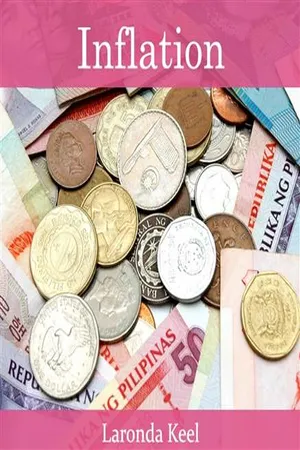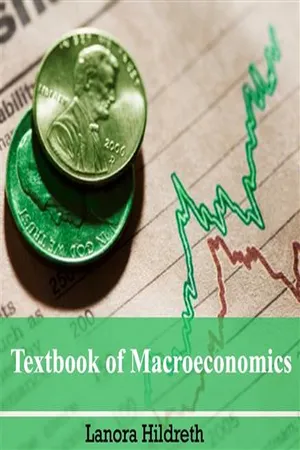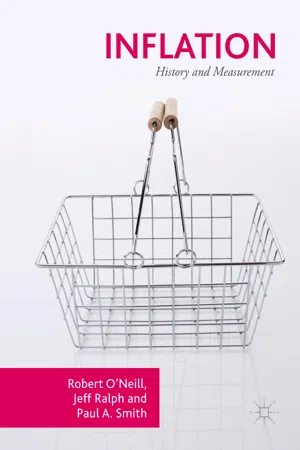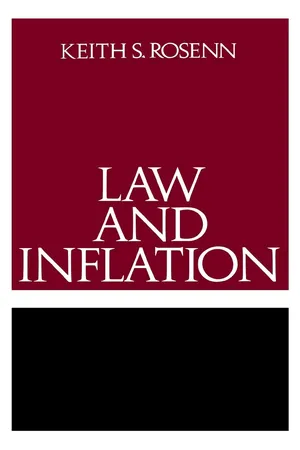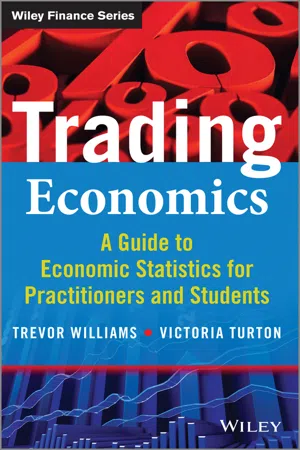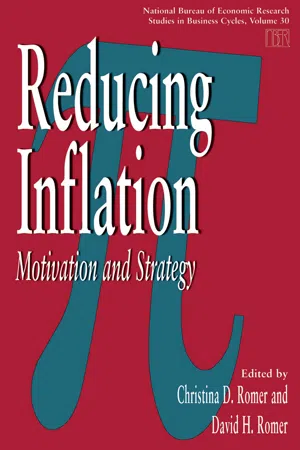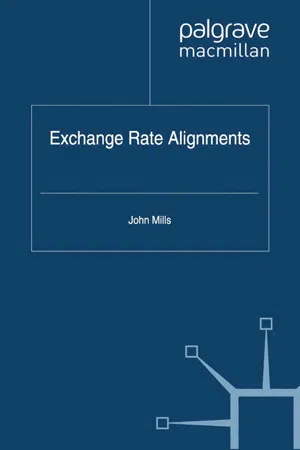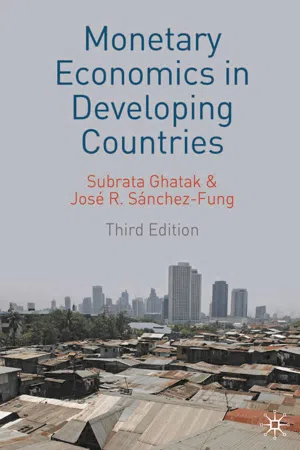Economics
Effects of Inflation
The effects of inflation include a decrease in the purchasing power of money, leading to higher prices for goods and services. Inflation can also impact savings and investments, as the real value of money declines. Additionally, it can create uncertainty and instability in the economy, affecting consumer and business confidence.
Written by Perlego with AI-assistance
Related key terms
1 of 5
11 Key excerpts on "Effects of Inflation"
- No longer available |Learn more
- (Author)
- 2014(Publication Date)
- Orange Apple(Publisher)
____________________ WORLD TECHNOLOGIES ____________________ Chapter- 1 Inflation In economics, inflation is a rise in the general level of prices of goods and services in an economy over a period of time. When the general price level rises, each unit of currency buys fewer goods and services. Consequently, inflation also reflects an erosion in the purchasing power of money – a loss of real value in the internal medium of exchange and unit of account in the economy. A chief measure of price inflation is the inflation rate, the annualized percentage change in a general price index (normally the Consumer Price Index) over time. Inflation's effects on an economy are various and can be simultaneously positive and negative. Negative Effects of Inflation include a decrease in the real value of money and other monetary items over time, uncertainty over future inflation may discourage investment and savings, and high inflation may lead to shortages of goods if consumers begin hoarding out of concern that prices will increase in the future. Positive effects include ensuring central banks can adjust nominal interest rates (intended to mitigate recessions), and encouraging investment in non-monetary capital projects. Economists generally agree that high rates of inflation and hyperinflation are caused by an excessive growth of the money supply. Views on which factors determine low to moderate rates of inflation are more varied. Low or moderate inflation may be attributed to fluctuations in real demand for goods and services, or changes in available supplies such as during scarcities, as well as to growth in the money supply. However, the consensus view is that a long sustained period of inflation is caused by money supply growing faster than the rate of economic growth. Today, most mainstream economists favor a low steady rate of inflation. - No longer available |Learn more
- (Author)
- 2014(Publication Date)
- White Word Publications(Publisher)
____________________ WORLD TECHNOLOGIES ____________________ Chapter-7 Inflation In economics, inflation is a rise in the general level of prices of goods and services in an economy over a period of time. When the general price level rises, each unit of currency buys fewer goods and services. Consequently, inflation also reflects an erosion in the purchasing power of money – a loss of real value in the internal medium of exchange and unit of account in the economy. A chief measure of price inflation is the inflation rate, the annualized percentage change in a general price index (normally the Consumer Price Index) over time. Inflation's effects on an economy are various and can be simultaneously positive and negative. Negative Effects of Inflation include a decrease in the real value of money and other monetary items over time, uncertainty over future inflation may discourage investment and savings, and high inflation may lead to shortages of goods if consumers begin hoarding out of concern that prices will increase in the future. Positive effects include ensuring central banks can adjust nominal interest rates (intended to mitigate recessions), and encouraging investment in non-monetary capital projects. Economists generally agree that high rates of inflation and hyperinflation are caused by an excessive growth of the money supply. Views on which factors determine low to moderate rates of inflation are more varied. Low or moderate inflation may be attributed to fluctuations in real demand for goods and services, or changes in available supplies such as during scarcities, as well as to growth in the money supply. However, the consensus view is that a long sustained period of inflation is caused by money supply growing faster than the rate of economic growth. Today, most mainstream economists favor a low, steady rate of inflation. - eBook - PDF
- John A. White, Kenneth E. Case, David B. Pratt(Authors)
- 2012(Publication Date)
- Wiley(Publisher)
First, it presents the definition of inflation in Webster’s New Universal Unabridged Dictionary published in 1983: ‘‘An increase in the amount of currency in circulation, resulting in a relatively sharp and sudden fall in its value and rise in prices; it may be caused by an increase in the volume of paper money issued or of gold mined, or a relative increase in expenditures as when the supply of goods fails to meet the demand.’’ Next, it provides the definition in Houghton Mifflin’s fourth edition of The American Heritage Dictio- nary of the English Language: ‘‘A persistent increase in the level of consumer prices or a persistent decline in the purchasing power of money, caused by an increase in available currency and credit beyond the proportion of available goods and services.’’ Then, InflationData.com concludes, ‘‘So between 1983 and 2000 the definition appears to have shifted from the cause to the result. Also, note that the cause could be either an increase in money supply or a decrease in available goods and services.’’ Although general agreement regarding the definition of inflation does not exist, consumers understand the impact of inflation on their ability to purchase goods and services. As the value of a dollar diminishes over time, the Effects of Inflation are manifested. In summary, inflation is characterized by a decrease in the purchasing power of money that is caused by an increase in general price levels of goods and services without an accompanying increase in the value of the goods and services. As noted above, inflationary pressure is created when more dollars are put into an economy without an accompanying increase in goods and services. In other words, printing more money without an increase in economic output generates inflation. Inflation can have such a significant impact on an investment’s economic worth that it should be considered when comparing investment alternatives. - eBook - PDF
Inflation
History and Measurement
- Robert O'Neill, Jeff Ralph, Paul A. Smith(Authors)
- 2017(Publication Date)
- Palgrave Macmillan(Publisher)
22 R. O’Neill et al. 2.1 Why Does Inflation Matter? Imagine trying to negotiate a pay rise with your boss without knowing what the recent level of inflation has been. You might tell your boss that the cost of the things you buy has increased over the course of the past year, while they might argue that their experience has been that prices are falling. If we then abstract this argument to a broader level and con- sider the bargaining positions of unions and management teams, it may help to make it clear what might be a sensible wage increase to maintain the purchasing power of workers’ wages. 1 Such concerns do not only affect those working but also affect those in receipt of benefits. A pen- sioner who is given a pension on retirement will see their ability to pur- chase consumer goods fall if price levels rise, and so they are likely to be keen to make sure that benefit payments keep pace with changes in the level of prices in a given area during a given passage of time. 2.2 The Language of Inflation Before moving on it is useful to consider the common definition of inflation and the definitions of related terms as they are commonly understood by economists, who are likely to make the most frequent use of such terms. The OED definition of inflation (relating to economics) is that it defines a general increase in prices and a fall in the purchas- ing value of money, see OED (2017). Similar definitions of inflation are offered by some of the leading textbooks aimed at students of econom- ics 2 although their focus is much more on the first part of this defini- tion—that inflation is defined as a general increase in price levels. For many people, a definition of inflation as the increase in the price levels experienced in an economy may be enough for them to be happy that they understand it. - eBook - PDF
- Keith S. Rosenn(Author)
- 2015(Publication Date)
- University of Pennsylvania Press(Publisher)
INFLATION'S CAUSES AND CURES The term inflation is often used loosely in English to mean anything from pomposity to increases in money, income, and profits. 1 For the pur-poses of this book, inflation is used to refer either to a sustained rise in an economy's general level of prices or to a corresponding fall in the domestic purchasing power of an economy's currency. This working definition im-plies that inflation is a dynamic process in which the aggregate level of prices is moving upward over time while the purchasing power of money is in corresponding decline. It does not mean that all prices are moving upward uniformly, nor even that all prices are moving upward. It does mean that an economy is undergoing inflation when it presently costs more to purchase a representative sample of goods than it cost in the past. Inflation and its opposite, deflation, describe changes in a nation's internal price levels or its currency's domestic purchasing power. Changes in a currency's external purchasing power occur through adjust-ments in the foreign exchange rate. When the value of country A's cur-rency declines relative to the currency of country B, there has been a devaluation of country A's currency. Correspondingly, there has been an upward revaluation in country B's currency relative to country A. In com-mon parlance references to changes in internal and external purchasing power of a currency are frequently commingled; it is not uncommon to find courts confusingly referring to devaluation when they really mean depreciation in domestic purchasing power. 2 In the long run, countries experiencing inflation rates higher than those of customary trading part-ners will be forced to devalue; however, in the short run, it is frequently possible for countries to maintain the same exchange rate despite sub-stantial domestic inflation, or to devalue by less than the inflation rate differential. - R. Albert Berry(Author)
- 2019(Publication Date)
- Routledge(Publisher)
Both of the above factors imply a demand pull type of inflation. While cost increases doubtlessly played a role in the propagation of inflationary impulses, it is not plausible to argue that they were the major causal factor. The primary direct mechanisms by which inflation affects pretax income dis-tribution are through its effects on real wages and through its effects on the prices and returns to the various assets and obligations held by individuals (or families) at different income and wealth levels. Inflation may also alter the relative tax burden on different groups, altering the relationship between the after-tax and before-tax distributions. There are many less direct Effects of Inflation, as for example through its effect on the rate or type of growth; under inflation the benefits may be distributed differently from those of a noninflationary growth process. Among the innumerable indirect effects which are possible, only those most likely to be relevant are considered below. In appraising the Effects of Inflation one may also consider whether it was caused by policies which themselves had distributional effects. If a rapid expan-sion of government spending on the poor were to cause inflation, it may be more relevant to consider the distributional effects of the inflation producing policy, including both the direct effects and those operating through the inflation than to focus only on the latter. The likelihood that a given increase in public spending or reduction in taxes may trigger an inflation is a key consideration in the predic-tion of its distributional effects. Hence, the double importance of judging how inflation affects distribution. There are many reasons to believe that the effects of a continuous and, there-fore, generally anticipated inflation on the real values of economic variables would be different from those of an unanticipated one, usually synonomous with an acceleration of the rate of price increase.- eBook - PDF
Trading Economics
A Guide to Economic Statistics for Practitioners and Students
- Trevor Williams, Victoria Turton(Authors)
- 2014(Publication Date)
- Wiley(Publisher)
4 Inflation Inflation is always and everywhere a monetary phenomenon in the sense that it is and can be produced only by a more rapid increase in the quantity of money than in output. Milton Friedman 1 WHAT IS INFLATION? Inflation tells us the changing (increasing) price of a range of goods or services; basically how much of something we can get for our money. The rate of change of prices – the speed at which the price of goods and services that are bought by households or businesses alter – is called inflation. But prices can also fall, in a process called deflation, sometimes termed negative inflation. Inflation is more common than deflation, or at least it has been in the last 50 years or so, and so it has become associated with changes in the price of goods and services. Historically, however, price falls were as common as price rises, as we will see later. Both inflation and deflation have advantages and disadvantages, which we will explore in more detail later in this chapter. THE HISTORY OF INFLATION Inflation has been around for a long time, but, as Figure 4.1 shows, the level of prices (the index) really only rose consistently and sharply in the UK from the 1970s onwards. This was after the US came off the gold standards and the Bretton Woods system of fixed exchange rates, which had prevailed after the Second World War, ended. Money was now backed by government fiat and trust rather than by gold. And exchange rates were no longer fixed but allowed to float freely. This seems to have led to a rapid rise in the level of prices or, in other words, to the Retail Prices Index. Before that, for hundreds of years, the level 1 Friedman, M., The Counter-Revolution in Monetary Theory (1970). 100 Trading Economics Retail Price Index (1987 = 100) 0 10 20 30 40 50 60 70 80 90 100 1264 1296 1328 1360 1392 1424 1456 1488 1520 1552 1584 1616 1648 1680 1712 1744 1776 1808 1840 1872 1904 1936 1968 2000 Figure 4.1 Price index over time. - eBook - PDF
Reducing Inflation
Motivation and Strategy
- Christina D. Romer, David H. Romer, Christina D. Romer, David H. Romer(Authors)
- 2007(Publication Date)
- University of Chicago Press(Publisher)
2. Inflation hurts my real buying power, it makes me poorer. 3. Other 1 2 3 US. all 7% 77% 15% n=110 Economists 49% 12% 40% n=78 Over six times as many in the general public chose 2, that inflation hurts real buying power, indicating that economists think in very different terms about inflation. One may conjecture that the favored answer from economists here reflects concerns about the process of inflation, the frictions that accompany it, rather than the change in the price level itself, while the favored answer from the general public would reflect suffering caused by the new higher price level in the face of fixed nominal incomes. Consistent with this popular impression that inflation hurts standard of liv- ing, the general public tends to see inflation as hurting most people, while economists see about 50% as being hurt (50% would be the fraction hurt if inflation caused a random redistribution of income among people).* B5. What percent of the population do you think is hurt when there is sudden, unexpected, high inflation? -% U S . all 69% (mean) n= 108 Economists 48% n=13 The majority among the general public in all the countries studied here ex- cept Brazil fully agree that high inflation can reduce the growth and economic progress of a country. C 11. Do you agree with the following statement? “Inflation rates over 30% to 40% a year can reduce the growth and economic progress of a country, especially in comparison with countries where inflation is under 5% a year.” 8. Katona (1975) tabulated a similar question to the general public. 30 Robert J. Shiller 1 2 3 4 5 Fully agree Undecided Completely disagree US. - eBook - PDF
- J. Mills(Author)
- 2012(Publication Date)
- Palgrave Macmillan(Publisher)
There is much evidence that the problems with inflation are more diverse and more manageable than is often recognised. Devaluation and the price level Those who believe that exchange-rate changes will affect prices are right in at least one sense. Any parity reduction is bound to exert upward pressure on the costs of all imported goods and services in the devaluing country. While the prices measured in the domestic currency of both imports and exports will almost certainly rise, the tendency for import costs to increase faster than export prices may worsen the terms of trade. In this sense, too, there is a direct cost to the economy. Furthermore, there is no value in a policy of depreciation unless it makes imports more expensive rela- tive to home market production. A major objective has to be to price out some imports by making it relatively cheaper than it was previously to produce locally rather than in other countries. It follows that without price increases for imported goods and serv- ices, there will be no new bias towards production from domestic output. 46 Exchange Rate Alignments The evidence presented in Table 3.1, however, indicates that other factors have to be taken into account. If, as is commonly supposed, only import prices were significant, then the figures in the table would show increasing inflation and declining living standards after a depreciation and not, generally speaking, the opposite. How then are the figures in the table to be explained? The answer is that devaluation’s impact on the price level is more complicated than is often recognised. Many effects are disinflationary rather than the reverse and tend to increase national income rather than reduce it. Obviously, the more exposed an economy is to foreign trade, the greater the immediate impact of exchange-rate changes on living standards and the price level. - eBook - PDF
- Subrata Ghatak, José R. Sánchez-Fung(Authors)
- 2017(Publication Date)
- Red Globe Press(Publisher)
The overall conclusion that might be suggested is that there are a number of reasons for expecting that inflation much in excess of 10 per cent per annum is likely to have an adverse effect on the long-run development of a country, since any positive impact on total investment can easily be outweighed by adverse effects on the composition of investment, the degree of monetization and the efficiency of the financial system. In the long run, growth and development may best be promoted by having a target rate of inflation of zero, while erring on the side of inflation rather than deflation. 9.3.1 Further empirical evidence on inflation and growth The evidence explained so far in this chapter assumes implicitly that there is a linear relationship between money and growth, and there is somewhat firm evidence that high inflation is bad for growth (see, for example, De Gregorio, 1992; Barro, 1995). However, an influential paper by Levine and Zervos (1993) revealed that inflation’s effect on output does not pass Leamer’s extreme bounds tests in growth regressions (see also Sala-i-Martin, 1997). That is, inflation is not associated robustly with economic growth in a statistical sense. Also, Bruno and Easterly (1998) showed that, after excluding countries with inflation rates above 40 per cent from growth regressions, inflation’s statistical significance diminishes. And other authors, such as Temple (2000), are rather sceptical about the literature examining the link between inflation and growth. Still, ongoing research efforts are making progress in improving our understanding of the critical relationship between inflation and growth. In particular, modelling the relationship among these variables has recently considered the relevance of looking at non-linear and threshold effects. That is, whether or not there is a certain level (threshold) of inflation beyond which it matters more, say, than at lower levels (non-linearity), in determining economic growth. - G.C. Harcourt(Author)
- 2019(Publication Date)
- Routledge(Publisher)
Allen (1967, pp. 86ff). Cf. also P. Cagan (1974) especially pp. 2-7. and 21-6. Leijonhufvud: Costs of Inflation 289 Consequently, even if the inflation were balanced, it works its way through jerkily. At double-digit rates (on some smoothed average), one may expect sizable price increases on some sub-set of goods to be announced every week. What are the implications? They can hardly be discussed without at least bending the 'rules of the game' a bit. First, of course, it becomes a bother to keep up with it all. Scale-economies will affect who does and who does not try hard to do so. Traders expecting to transact large quantities will invest considerable resources in keeping track of prices. (Still, one would not expect a 10-20 per cent inflation to be 'enough' to call forth inflation-trading specialists in large numbers -die Gulaschbaronen are not yet prominent amongst us). Most households will not try to maintain their stock of price-information at ijie 'quality' they normally desire -even as they spend more effort at it. If beef prices go up in every odd-numbered week and potatoes every even week, sensible beef-and-potato eaters will resign themselves to a constant proportions diet that is non-optimal every week -and curse the statisticians who assert their real income is unaffected by it all. Perhaps that sort of thing is not important. But another proposition, I feel, is: Transactors will not be able to sort out the relevant 'real' price signals from the relative price changes due to these inflationary leads and lags. How could they? Messages of changes in 'real scarcities' come in through a cacaphony of noises signifying nothing ... and 'sound' no different. To assume that agents generally possess the independent information required to filter the significant messages from the noise would, I think, amount to assuming knowledge so comprehensive that reliance on market prices for information should have been unnecessary in the first place.
Index pages curate the most relevant extracts from our library of academic textbooks. They’ve been created using an in-house natural language model (NLM), each adding context and meaning to key research topics.
